"이건 아마겟돈"···'기후 재앙' 호주 산불, '기후 자살'은 아닐까 [정리뉴스]"이건 아마겟돈"···'기후 재앙' 호주 산불, '기후 자살'은 아닐까 [정리뉴스]
본문듣기 설정
기사입력2020.01.10. 오후 6:06
최종수정2020.01.10. 오후 10:44
슬퍼요 화나요 좋아요 평가하기269
239요약봇beta
글자 크기 변경하기 SNS 보내기
원본보기호주 멜버른의 abc뉴스 니콜 애셔가 지난해 12월31일 트위터에 올린 사진. 애셔는 사진에 이렇게 덧붙였다. “이것이 지금 말라쿠타에서 벌어지고 있는 일이다. 엄마와 아이가 보트에 올라타 (불길로부터) 몸을 피했다. 사람들은 ‘시내에서 가스통 폭발하는 소리가 계속 들렸고, 많은 집들이 불에 탔다’고 설명했다.” | 니콜 애셔 트위터 캡처
사람들은 해변으로 달려갔다. 거센 불길이 마을을 덮쳤기 때문이다. 바다로 피신하라는 의미의 사이렌이 요란했고, 가스통들이 터지는 소리가 들렸다. 휴대폰 크기만한 불덩어리가 불쑥 불쑥 떨어졌다. 한낮인데 사방은 검고 붉었다. 불길은 나중엔 해안가까지 ‘진격’했고 일부는 배를 타야 했다. 열흘 전 호주 빅토리아주 말라코오타 해안가 마을에선, 이처럼 4000여명의 주민과 관광객들이 해안으로 달려가는 재난영화 같은 상황이 벌어졌다.
영국 일간 ‘가디언’에 따르면 말라코오타 주민들은 자신이 겪은 상황을 ‘아마겟돈’에 비유했다. 당시 가족들과 함께 배에 올라탔던 에이미 세비지는 BBC 기자에게 이렇게 말했다. “(얼마나 이러고 있어야 하는지) 알 수 없다는 것이 가장 무서웠다”

원본보기지난해 12월 31일 말라코오타 해안가에서 다시 배로 옮겨타 불길로부터 몸을 피한 주민들. 말쿠타|AFP연합뉴스
호주 대륙이 5개월째 불타고 있다. 그저 불길을 잡기 어려운 수준이 아니다. 피난행렬, 붉은 하늘, 군함까지 동원한 구조, 농장과 집을 지키려다가 사망한 사람들…. 호주의 시민들은 지금 ‘기후재앙’에 직면했다.
호주는 광활한 산림과 초목, 코알라와 캥거루를 연상시키는 국가이지만 실은 화석연료를 가장 많이 쓰는 나라 중 하나다. 소설가 리처트 플래너건은 뉴욕타임즈에 이렇게 기고했다. “지금 호주는 기후자살을 하고 있다(기고문 제목)” 기후변화를 외면한 응분의 대가를 치르고 있는 것 아니냐는 얘기다.
호주는 2016년 비영리단체들로부터 ‘기후악당국 4개국’ 중 한곳으로 지목됐는데 당시 이름을 나란히 올린 국가가 바로 한국이다. 지금도 호주나 한국이나 모두 기후대응 불량국가다. 독일 민간연구소 ‘저먼 와치’가 온실가스 배출량과 정부 에너지 정책 등을 반영해 내놓은 ‘기후변화대응지수’ 순위를 보면 58개국 중 호주는 53번째, 한국은 55번째다. 지금 한국사회가 호주에 벌어진 기후위기를 심각하게 받아들여야 하는 이유다. 호주 산불에 대해 우리가 알아야 할 것들을 정리했다.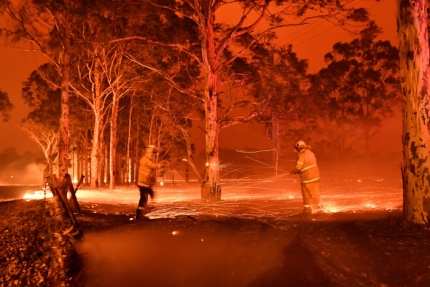
원본보기호주 뉴사우즈웨일스주(NSW)의 나우라 지역에서 지난달 31일(현지시간) 현지 소방관들이 나무에 붙은 불을 끄기 위해 물을 뿌리고 있다. 나우라|AFP연합뉴스
■피해 동물 10억 마리… 일부는 멸종 위기에
호주 산불의 심각성을 가장 극명하게 보여주는 숫자는 ‘10억마리’라는, 헤아리기도 힘든 수준의 피해동물 규모다. 인간은 도망칠 수 있었지만 야생동물들은 불에 무방비로 노출됐다. 동물 10억마리가 피해를 입었을 것이란 추정은 시드니대 생태학자 크리스토머 딕먼이 내놓은 것으로 그는 이달 초까지만 해도 5억마리로 파악을 하고 있었다. 하지만 불이 호주 뉴사우즈웨일즈(NSW)주에서 빅토리아주로 번지며 추정치를 대폭 늘릴 수 밖에 없었다.
그러나 이마저도 정확한 규모가 아니다. 산불이 완전히 잡히기 전까지는 얼마나 많은 동물이 죽었는지 정확히 조사할 방법이 없다. 또 박쥐를 제외한 새와 파충류, 포유류를 포함하는 대신 곤충, 개구리 등은 제외돼 실제 숫자는 훨씬 많을 것으로 추정된다.
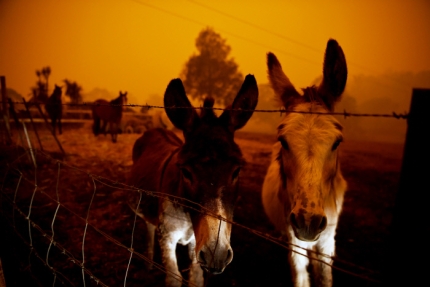
원본보기지난 5일 호주 뉴사우즈웨일스주(NSW)의 코바고 지역의 한 농장. 코바고|로이터연합뉴스
특히 호주의 상징인 코알라의 경우 산불 발생 이후 8000마리 넘게 목숨을 잃었다. 서식지의 80%가 파괴돼 전문가들은 코알라가 ‘기능적 멸종’ 상태에 들어갔다고 보고 있다. 기능적 멸종 상태는 특정 종의 개체 수가 너무 줄어 더 이상 생태계에서 역할을 하지 못하면서 장기적 생존 가능성이 낮다는 뜻이다. 코알라 외에 주 남동부에만 서식하는 회색머리날여우박쥐와 캥거루섬에서만 사는 유대류 동물 두나트도 떼죽음을 당했다. 가축도 예외는 아니다. 당국은 소 10만 마리가 이번 산불에 목숨을 잃을 것이라고 보고 있다. 송아지에게 젖을 먹이기를 멈춘 젖소가 늘었다는 보고도 나온다.

원본보기지난해 12월22일 호주 커들리 크릭 지역에서 코알라가 구조되는 모습. 물을 급하게 마시고 있다. 커들크릭|AP연합뉴스
전문가들은 이번 산불로 대륙 내 생물다양성이 파괴될 것을 우려한다. 호주는 세계 최대 생물다양성 중심지 중 하나다. 수백만 년 이상 고립돼 인간의 영향 없이 동물 진화가 이뤄지면서 독특한 생태계가 형성됐다. 약 244종의 포유류가 오직 호주에서만 서식한다. 호주 뉴잉글랜드대 생태학자 마누 손더스는 “숲에는 수백만의 개체가 있고, 수백 종의 생물들이 서로 의지해 살고 있다. 이것은 마치 사슬의 연결고리와 같아서 한 종을 잃으면 이와 연결된 다른 종들도 잃게 된다”고 말했다. 실제 보호식물이 사라진 일부 지역에서는 두나트 등 작은 동물들이 여우 등에 의해 희생되고 있다.

원본보기
호주에선 자원봉사자들이 나서서 불길에 갇힌 코알라를 구해내고 있다. 사진은 다친 코알라를 돌보고 있는 모습. 캥거루섬|EPA연합뉴스
호주 국립대학의 생태학자 사라 레지 또한 “수백 종의 생물이 이 산불의 영향을 받았다. 그 중에는 수십 종의 멸종위기종이 포함돼있다. 이 사건으로 인해 일부가 멸종 위기에 처할 것이며, 멸종되지 않는다 하더라도 이것은 그들에게 ‘끝의 시작’이 될 것”이라고 경고했다.
한편 덥고 건조한 날씨까지 이어지면서 소방당국은 불길을 잡는 데 어려움을 겪고 있다. 기상당국은 3월까지 평균보다 더 덥고 건조한 날씨가 계속돼 사태가 더 악화될 가능성이 있다고 보고 있다. 셰인 피츠시몬스 NSW주 산불방재청(RFS)장 또한 2월이 돼야 화재에 영향을 미칠 만큼 비가 내릴 것이라고 경고했다.
관련뉴스 보기>>
호주 산불 다섯 달째, 야생동물 10억마리 폐사…보호종 날여우박쥐 멸종위기
핏빛 하늘…호주 산불 “최악의 상황”
‘그을린 호주’ 어루만져주는 손길
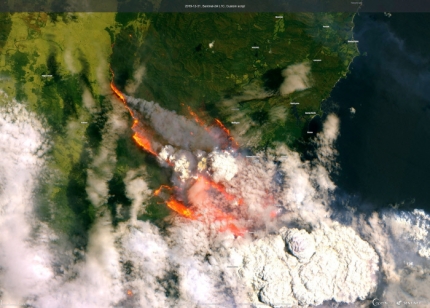
원본보기지난해 12월31일 위성사진으로 본 호주 산불 모습. AP연합뉴스
----------
■왜 산불이 계속되나…기후변화에 의한 극강의 ‘고온건조’호주에서 대규모 산불이 장기화되고 있는 것은 ‘이상기후’ 때문일 가능성이 높다. 호주는 현재 여름철이고 이 시기 원래 덥고 건조했지만, 최근에는 이례적인 수준의 고온건조함이 계속되고 있다. 불 나기 쉽고 끄기는 어려운 기후가 형성된 것이다. 호주와 맞닿은 인도양 해수면 온도의 변화, 약화된 남극진동 등 호주를 고온건조하게 만든 요인들에 대해 학자들은 기후변화와 관련이 있다는 분석을 내놓고 있다.
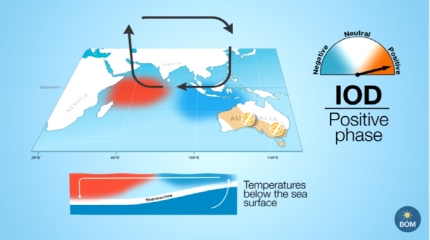
원본보기호주 기상청의 인도양 다이폴에 관한 설명 | 호주 기상청 유튜브 캡처
호주 대륙의 ‘건조함’를 심화시킨 요소 중 하나는 ‘인도양 다이폴(인도양 쌍극자·Indian Ocean Dipole)’이다. 인도양 다이폴은 인도양 동·서부의 수온이 주기적으로 바뀌는 현상을 말하는데 ‘양의 주기’에 들어서면 인도양 서부의 수온이 오른다. 이때 인도양 동부에 위치한 호주대륙에선 전국이 바짝 마르고 비가 거의 오지 않는다. 공기 중 수분이 인도양의 뜨거운 쪽으로 빨려들어가기 때문이다.
과학자들에 따르면 인도양 다이폴 현상은 최근 더 빈번해지고 심해졌는데, 그 이유로 지구온난화가 지목되고 있다. 미국의 해양과학자 캐롤라인 우멘호퍼는 지난해 11월 ‘가디언’지에 “지구가 뜨거워진 지난 50년 동안 인도양 다이폴이 더 일상화됐다는 연구결과가 있다”고 설명했다. 지난해 250만명이 침수 피해를 입은 아프리카의 대규모 홍수 역시 ‘인도양 다이폴’ 때문이라는 분석이 나온다. 홍수가 일어난 아프리카 지역들은 인도양 동부에 있다.
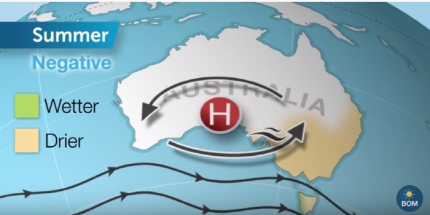
원본보기호주 기상청의 남극진동 관련 현상에 관한 설명 | 호주 기상청 유튜브 캡처
호주 산불을 악화시킨 또다른 요인은 ‘남극진동’이다. 남극과 북극에는 이곳의 찬 바람이 중위도 지역으로 흘러내려오지 못하게 하는 ‘바람 장막’이 띠의 형태로 둘러져 있는데, 이 장막의 세기가 주기적으로 달라지기 때문에 ‘진동’이라 부른다. (북극진동이 약화되면 한국엔 혹독한 추위가 몰려온다.)
바람 장막 반경이 줄어드는 남극진동 '음의주기'가 오면 호주 대륙은 뜨겁고 건조해진다.
멜버른 모나시대학 ARC기후변화센터 연구팀이 지난 37년간의 기후자료를 분석해 보니 남극진동이 약해질 때 호주 대륙의 고온·건조한 정도는 4~8배 심해졌다고 한다.
올해 남극진동의 세기는 약해졌는데, 그 결과는 극단적으로 나타났다. 여름 ‘초입’이었던 지난해 12월17일 호주의 전국 평균 기온은 섭씨 40.8도로 나타나 최고 기록을 경신했다. 그런데 이 기록은 다음날인 18일 곧바로 깨졌다. 그날의 전국 평균 기온은 41.8도였다.
호주의 뉴사우스웨일즈주립대 사라 퍼킨스 커크패트릭 교수는 미국 온라인 매체 ‘복스’와의 인터뷰에서 “
기후변화가 아니라면 이렇게 심각한 고온 현상이 나타날 가능성은 아주 낮다”고 말했다. 최근 수년간의 극심한 더위 때문에 호주의 평균기온이 1910년보다 1도 올랐을 정도다(호주 기상청의 2018년 보고서).
관련뉴스>>
호주, 전국 평균 40.9도 최악 폭염...승용차에서 돼지고기도 구워
[구정은의 ‘수상한 GPS’] 남극 바람이 바뀌니 불길이 치솟는다...메가파이어, 기후변화의 역습
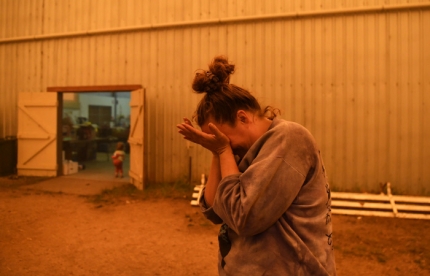
원본보기
호주 뉴사우즈웨일스주(NSW)에서 산불 관련 기부 활동하고 있는 한 봉사자가 지난 5일(현지시간)물 확보의 어려움을 토로하며 눈물을 보이고 있다. 코바고|로이터연합뉴스
■
아직도 한가한 호주 정부호주 정부는 이번 산불이 ‘기후 재앙’임을 외면하고 있다. 스콧 모리슨 총리는 산불과 기후변화의 연관성을 줄곧 부인해왔다. 지난해 11월 모리슨 총리는 둘 사이의 인과관계를 묻는 취재진 질문에 “오늘은 목숨을 잃은 사람들과 가족에 대한 생각 뿐”이라며 답변을 피했다. 마이클 맥코맥 부총리는 같은 질문에 “미쳐날뛰는 도심지의 좌파들(의 주장)”이라고 응수했다.
정부의 태도에 여론이 들끓었다.
모리슨 총리는 산불 발생 6개월 만인 지난달 12일 결국 기후변화가 산불의 원인 중 하나라고 인정했다. 그는 이날 기자회견에서 “이번 산불과 관련된 많은 기여 요인이 있다”며 “우리 모두 기후변화가 다른 요소와 함께 오늘날 일어난 일(산불)에 기여한 것을 알고 있다”고 했다. 그러면서도 “가뭄은 분명한 요인 중 하나이고, 가장 큰 것은 건조한 덤불”이라고 강조했다.모리슨 총리는 왜 기후변화를 말하지 않을까. 지난해 11월 모리슨 총리의 발언에서 힌트를 얻을 수 있다. 당시 그는 기후변화 관련 집회를 금지해야 한다며 “그들이 이 나라의 광업에 해를 입히고 있다”고 말했다.
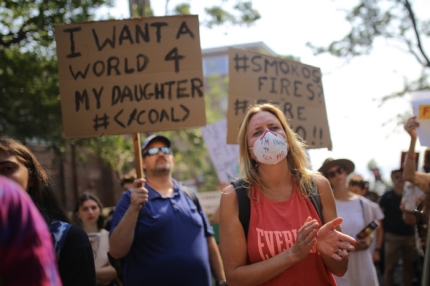
원본보기
호주 시민들이 지난달 19일(현지시간) 시드니에서 산불 사태 중 휴가를 떠난 스콧 모리슨 총리에게 항의하며 시위를 벌이고 있다. 시드니|EPA연합뉴스
호주는 현재 세계 최대 석탄 수출국이다. 호주가 수출하는 화석 연료의 온실가스 배출량은 전세계 배출량의 약 7%를 차지한다. 전문가들은 호주의 석탄산업이 기후변화를 앞당기고 있다며 석탄 의존도를 낮춰야 한다고 주장해왔다. 사상 최악의 산불이 발생한 이후 이 같은 목소리가 더 커졌다. 그러나 석탄 산업의 강력한 지지자인 모리슨 총리는 적극 방어에 나서고 있다. 그는 최근 한 방송에서 “전통적인 산업에서 벗어나 수천 명의 호주인들의 일자리를 빼앗는 일은 하지 않을 것”이라고 말했다.
호주 정부에 따르면 호주 석탄산업에 종사하고 있는 인구는 약 3만8000명이다.
원본보기
온실가스 배출량, 에너지 사용량, 기후변화 대응 정책 등을 종합한 ‘기후변화 대응지수’ 순위상 최하위국들. 꼴찌(61위)는 ‘미국’이고 호주는 56위, 한국은 58위다. (1~3위는 해당되는 국가가 없다) |GermanWatch 기후변화대응지수(CCPI) 홈페이지 캡처
그러는 사이 호주의 상황은 급속도로 나빠졌다. 지난달 초 발표된 ‘기후변화대응지수(CCPI) 2020’에서 호주는 전체 58개 국가 중 최하위 수준인 53번째에 이름을 올렸다. 한국은 55번째다. (순위로는 호주·한국 각각 56위, 58위다. 그러나 1~3위에는 해당하는 국가가 없다.)
호주 정부는 오는 2030년까지 온실가스 배출량을 2005년 수준보다 26~28% 줄일 것을 목표로 하고 있다. 전문가들은 그러나 이 수치가 파리기후협정의 목표 달성에 충분하지 않다고 주장한다.
가디언은 “2013년부터 호주 총리와 그 전임자들은 기후변화와 악화되는 산불 간 관련성을 지적하는 최소 18개 이상의 전문가 경고를 받았지만, 모두 무시했다”며 “모리슨 총리와 다른 정치인들은 기후 비상사태를 초래하는 배기가스 감소 조치를 취하지 않았을 뿐 아니라 예측된 재난적 상황에 적절하게 준비하지 못한 것이 분명하다”고 전했다.
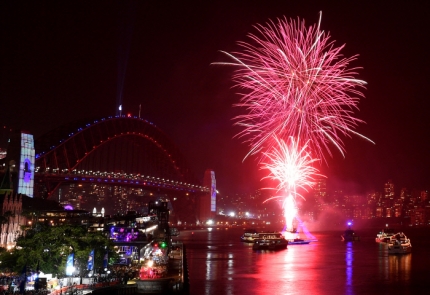
원본보기지난해 12월31일 시드니에서 진행된 ‘불꽃놀이’ . 산불 재난이 계속되고 있음에도 정부가 불꽃놀이를 실시해 비판 여론이 일었다. 시드니|EPA연합뉴스
여기에 정부와 정치 지도자들의 안이함은 기름을 부었다. 모리슨 총리는 지난달 크리스마스 휴가를 하와이에서 보내다 여론의 뭇매를 맞고 급히 귀국했다. 그는 “끔찍한 산불로 피해를 본 호주인 누구든지 나의 휴가 때문에 불쾌해졌다면 깊이 유감”이라며 사과 성명을 발표했다. 야당인 노동당의 대표는 지난달 탄광마을을 찾아 석탄산업에 대한 지지를 표명했고, 최대 도시 시드니 정부는 “이럴 때가 아니다”라는 반대 여론에도 새해맞이 불꽃축제를 강행했다.
민심은 돌아서고 있다. 지난 2일 모리슨 총리는 산불 피해 현장인 NSW주의 한 마을을 찾았다 조롱과 야유를 받고 쫓기듯 현장을 떠났다. 주민들은 “당신은 아웃” “여기서 표를 얻을 생각 하지도 마, 이제 보수당에 표를 주지 않을 것”이라고 반응했다.

원본보기
재앙급 화재 중 미 하와이로 휴가를 가버린 스콧 모리슨 총리를 풍자하는 ‘밈’ . 휴양지에서 쓰는 화관을 쓰고 옷차림 역시 하와이풍이다.
관련뉴스>>
국가재난급 산불에 ‘하와이 휴가’가 웬말
산불 퍼지니 기후위기 실감...반정부 시위 나선 시드니 시민들
최민지·송윤경 기자 ming@kyunghyang.com



 원본보기호주 멜버른의 abc뉴스 니콜 애셔가 지난해 12월31일 트위터에 올린 사진. 애셔는 사진에 이렇게 덧붙였다. “이것이 지금 말라쿠타에서 벌어지고 있는 일이다. 엄마와 아이가 보트에 올라타 (불길로부터) 몸을 피했다. 사람들은 ‘시내에서 가스통 폭발하는 소리가 계속 들렸고, 많은 집들이 불에 탔다’고 설명했다.” | 니콜 애셔 트위터 캡처
원본보기호주 멜버른의 abc뉴스 니콜 애셔가 지난해 12월31일 트위터에 올린 사진. 애셔는 사진에 이렇게 덧붙였다. “이것이 지금 말라쿠타에서 벌어지고 있는 일이다. 엄마와 아이가 보트에 올라타 (불길로부터) 몸을 피했다. 사람들은 ‘시내에서 가스통 폭발하는 소리가 계속 들렸고, 많은 집들이 불에 탔다’고 설명했다.” | 니콜 애셔 트위터 캡처 원본보기지난해 12월 31일 말라코오타 해안가에서 다시 배로 옮겨타 불길로부터 몸을 피한 주민들. 말쿠타|AFP연합뉴스
원본보기지난해 12월 31일 말라코오타 해안가에서 다시 배로 옮겨타 불길로부터 몸을 피한 주민들. 말쿠타|AFP연합뉴스 원본보기호주 뉴사우즈웨일스주(NSW)의 나우라 지역에서 지난달 31일(현지시간) 현지 소방관들이 나무에 붙은 불을 끄기 위해 물을 뿌리고 있다. 나우라|AFP연합뉴스
원본보기호주 뉴사우즈웨일스주(NSW)의 나우라 지역에서 지난달 31일(현지시간) 현지 소방관들이 나무에 붙은 불을 끄기 위해 물을 뿌리고 있다. 나우라|AFP연합뉴스 원본보기지난 5일 호주 뉴사우즈웨일스주(NSW)의 코바고 지역의 한 농장. 코바고|로이터연합뉴스
원본보기지난 5일 호주 뉴사우즈웨일스주(NSW)의 코바고 지역의 한 농장. 코바고|로이터연합뉴스 원본보기지난해 12월22일 호주 커들리 크릭 지역에서 코알라가 구조되는 모습. 물을 급하게 마시고 있다. 커들크릭|AP연합뉴스
원본보기지난해 12월22일 호주 커들리 크릭 지역에서 코알라가 구조되는 모습. 물을 급하게 마시고 있다. 커들크릭|AP연합뉴스 원본보기
원본보기 원본보기지난해 12월31일 위성사진으로 본 호주 산불 모습. AP연합뉴스
원본보기지난해 12월31일 위성사진으로 본 호주 산불 모습. AP연합뉴스 원본보기호주 기상청의 인도양 다이폴에 관한 설명 | 호주 기상청 유튜브 캡처
원본보기호주 기상청의 인도양 다이폴에 관한 설명 | 호주 기상청 유튜브 캡처 원본보기호주 기상청의 남극진동 관련 현상에 관한 설명 | 호주 기상청 유튜브 캡처
원본보기호주 기상청의 남극진동 관련 현상에 관한 설명 | 호주 기상청 유튜브 캡처 원본보기
원본보기 원본보기
원본보기 원본보기
원본보기 원본보기지난해 12월31일 시드니에서 진행된 ‘불꽃놀이’ . 산불 재난이 계속되고 있음에도 정부가 불꽃놀이를 실시해 비판 여론이 일었다. 시드니|EPA연합뉴스
원본보기지난해 12월31일 시드니에서 진행된 ‘불꽃놀이’ . 산불 재난이 계속되고 있음에도 정부가 불꽃놀이를 실시해 비판 여론이 일었다. 시드니|EPA연합뉴스 원본보기
원본보기
